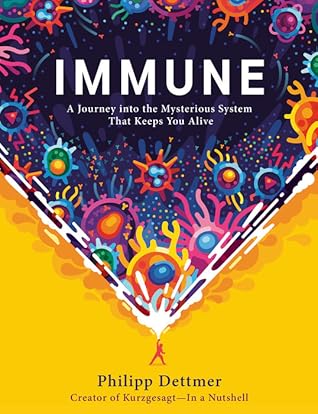More on this book
Community
Kindle Notes & Highlights
Read between
December 6, 2021 - January 8, 2022
Activation usually begins with an initial exposure of immune cells to intruders, like bacteria, or danger signals, like the insides of dead cells. For example, Macrophages get activated when they notice an enemy and release cytokines that call up Neutrophils and cause inflammation. The Neutrophils themselves release more Cytokines, causing more inflammation and reactivating Macrophages, who continue fighting. Complement proteins stream into the site of infection from the blood, attack pathogens, opsonize them, and help the soldier cells to swallow the enemies. Dendritic Cells sample enemies
...more
As more and more enemies are killed and their numbers are dwindling, fewer and fewer battle cytokines are released, because fewer immune cells are stimulated by ongoing fights. This means no more new soldiers are called in while the old ones die off or stop fighting. The cytokines that cause inflammation are used up relatively quickly, so without new and engaged soldiers that constantly release new cytokines, the inflammation reactions begin receding naturally, which also slowly has the complement system fizzle out. Fewer signals from the battlefield means that the activation of new T Cells
...more
This highlight has been truncated due to consecutive passage length restrictions.
To artificially induce the creation of Memory Cells that stick around for years, we need to activate your immune system for real. And this means it has to go through the proper steps of escalation. Two-factor authentication and all of that jazz. So we must somehow safely provoke a proper immune response but avoid causing the actual disease we want to protect ourselves against. There are a few different ways to do this. The first method basically comes back to the original principle of variolation. What if we could sort of cause the disease we want to immunize against, but just a really, really
...more
This highlight has been truncated due to consecutive passage length restrictions.
upgrade their immune system and protect them against the target of the vaccine for the remainder of their lives. Using living pathogens is not always an option though. Just like you can’t domesticate great white sharks, some pathogens refuse to be tamed and become properly weak. In some cases the risk of them causing the disease we want to protect against is just too high. So another method is to straight up kill the pathogen before injecting it, which is called an inactivated vaccine. You get a high number of the pathogenic bacteria or viruses together and then you destroy them with
...more
This highlight has been truncated due to consecutive passage length restrictions.
If you read this far you already know more about immunology than 99% of the general population.
Beware headlines about anything health related that mentions animal models. Yes, it is crucially important to test drugs in animals, but unsurprisingly, animals and humans are different. Yes, we have created mice with immune systems that basically mirror our human immune system, yes, we have monkeys like macaques that live on an evolutionary branch that is not that far away from ours, but these are still completely different organisms.


